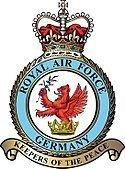Active 1 January 1959 - 1993 Nickname(s) RAFG Founded 1945 Allegiance United Kingdom | Motto Keepers of the Peace | |
 | ||
Similar Royal Air Force, British Army of the Rhine, RAF Strike Command, RAF Second Tactical A, Joint Force Harrier | ||
The former Royal Air Force Germany (RAFG) was a command of the Royal Air Force and part of British Forces Germany. It consisted of units located in Germany, initially as part of the occupation following the Second World War, and later as part of the RAF's commitment to the defence of Europe during the Cold War.
Contents
History
From 1954 Canberra bombers equipped 69 (briefly), 102, 103, 104, 149 Squadrons, and later 59 Squadron at RAF Gütersloh. This force was under Bomber Command control from Britain and had been moved because of overcrowding of suitable airfields in the UK to Germany. With the establishment of the British nuclear bomber forces in the context of NATO's strategy of massive retaliation the Canberra bomber squadrons were again withdrawn from Germany.
After 1955, the majority of the air bases were handed over to the newly established German Air Force and RAF Bückeburg to the army of the German Armed Forces. The number of RAF squadrons were reduced. This was both because of the nuclear strategy of NATO and for financial reasons after the fiasco of the Suez crisis . From 1 January 1959, the command was officially called Royal Air Force Germany, the RAF Second Tactical Air Force (2TAF) renamed. At this time the focus was the flying units already on just six main use bases RAF Bruggen, RAF Geilenkirchen, RAF Gutersloh, RAF Jever (No. 2 Squadron, Swifts), RAF Laarbruch and RAF Wildenrath. Important aircraft types at this time were the Canberra as night fighting-suited fighter bombers to three and the Hunter as a day fighter stationed at two airports. From 1960, around the clock there were two on alert Canberra loaded with tactical nuclear weapons who were ready within 15 minutes. In addition there were two seasons that the Swift used them as scouts and four squadrons of Gloster Javelin all-weather interceptors. Two English Electric Lightning squadrons - No. 92 Squadron RAF and No. 19 Squadron RAF - arrived in Germany from 1965.
Jever was transferred in 1961 and Geilenkirchen in 1968, reducing the command to four flying airfields. When Geilenkirchen closed, it appears there were two flying squadrons at the base. No. 3 Squadron RAF moved to Laarbruch and No. 92 Squadron RAF moved to Gutersloh.
RAF Germany was disbanded as a separate command in 1993 as part of the reduction of British Armed Forces presence in Europe at the cessation of the Cold War. The remaining RAF forces in Germany ceased to be a separate command, and instead became No 2 Group RAF, part of RAF Strike Command. No. 2 Group was then disbanded on 1 April 1996 by being absorbed into No. 1 Group RAF.
